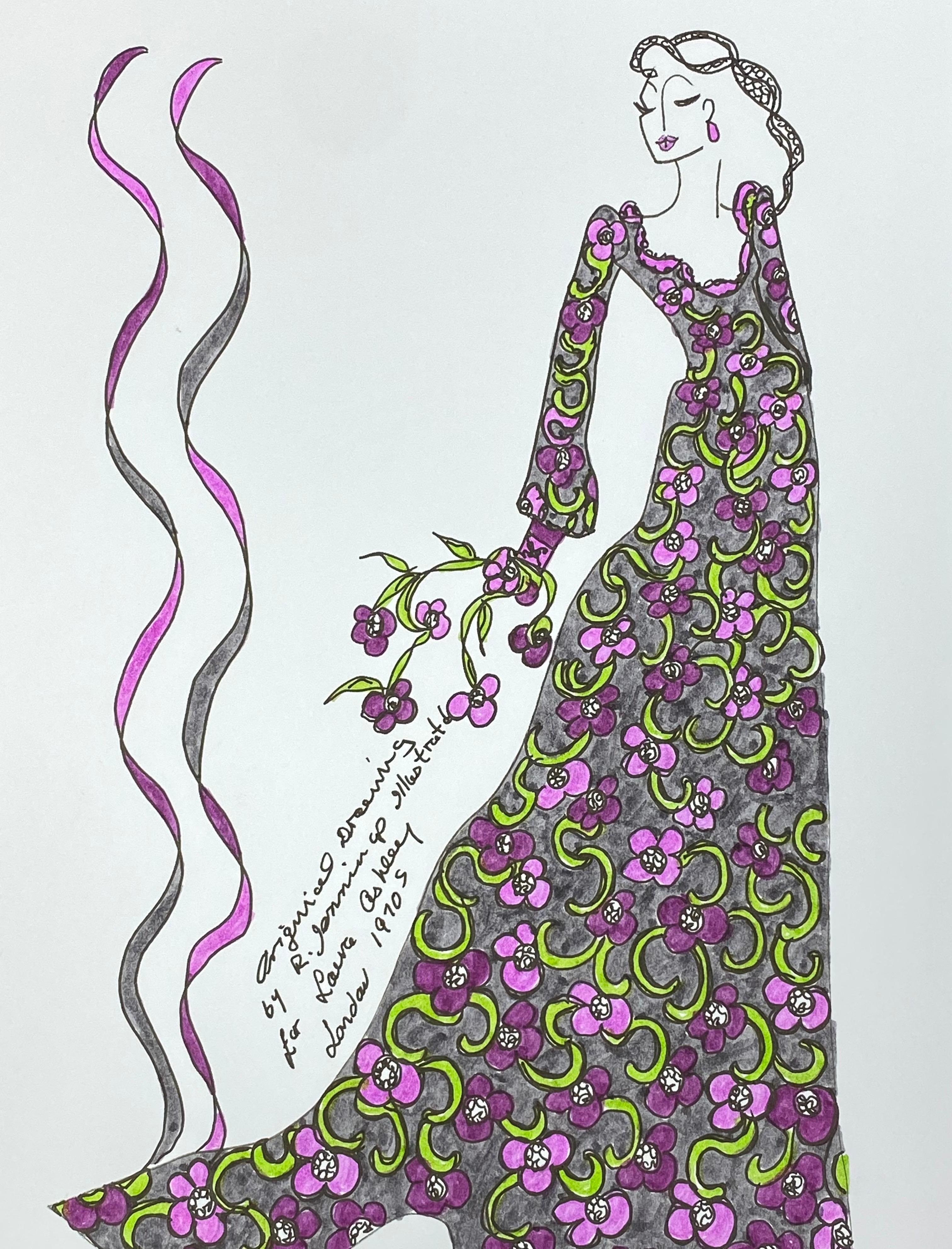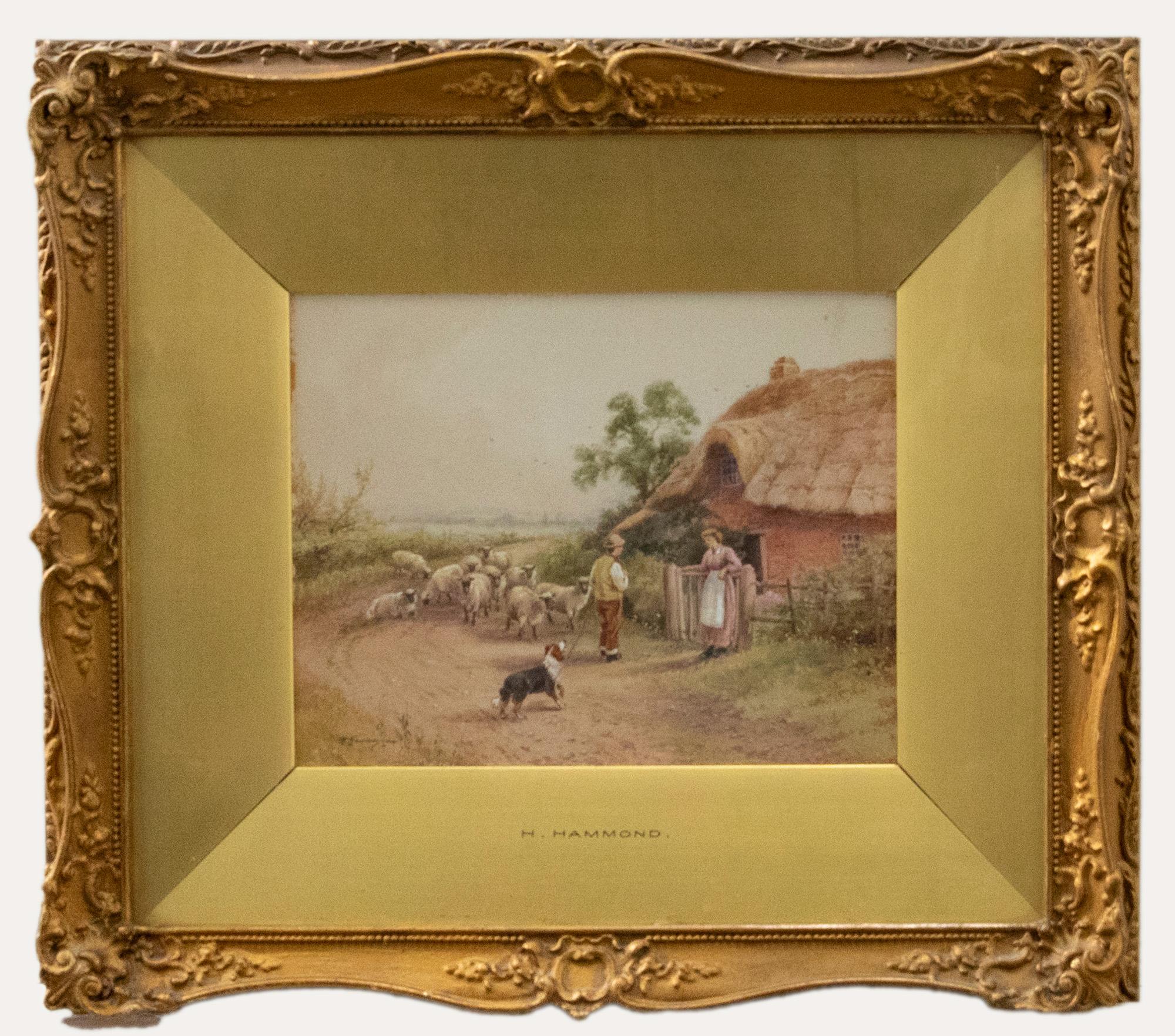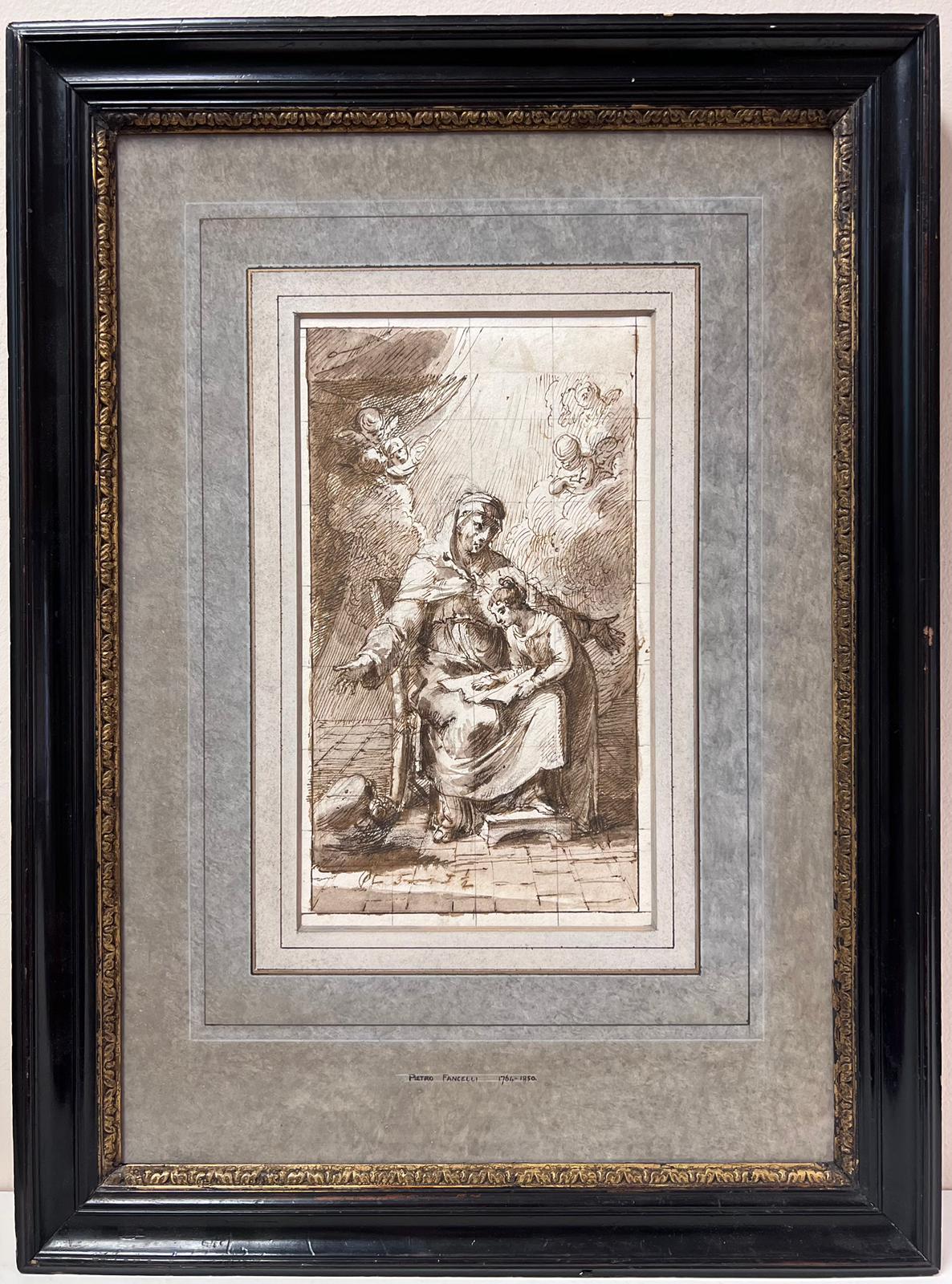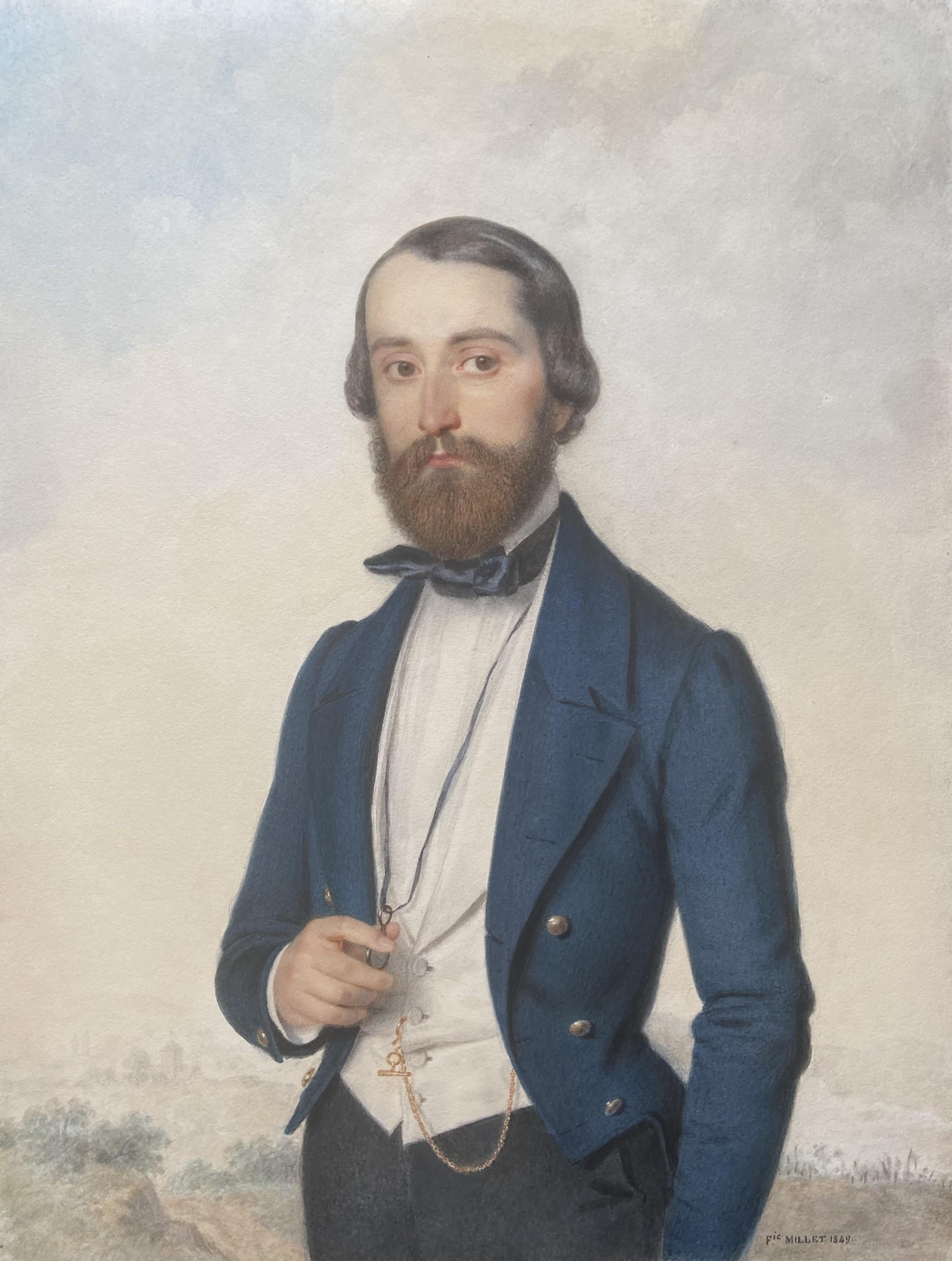Items Similar to Figures - Original Watercolor on Paper - 1920s
Want more images or videos?
Request additional images or videos from the seller
1 of 2
UnknownFigures - Original Watercolor on Paper - 1920sMid 20th Century
Mid 20th Century
About the Item
Figures is an original artwork realized by a French artist in the 1920s.
Original watercolor on cardboard.
The signature of the artist is present on the lower right corner in pencil.
Mint conditions.
Excellent painting work on paper depicting a couple of figures with elegant dresses. The figures are dancing and the background is realized with a large spot of beige delicate and warm beige color.
- Creation Year:Mid 20th Century
- Dimensions:Height: 12.41 in (31.5 cm)Width: 9.06 in (23 cm)Depth: 0.04 in (1 mm)
- Medium:
- Period:
- Framing:Framing Options Available
- Condition:Insurance may be requested by customers as additional service, contact us for more information.
- Gallery Location:Roma, IT
- Reference Number:
About the Seller
4.9
Platinum Seller
These expertly vetted sellers are 1stDibs' most experienced sellers and are rated highest by our customers.
1stDibs seller since 2017
6,757 sales on 1stDibs
Typical response time: 2 hours
- ShippingRetrieving quote...Ships From: Grasse, France
- Return PolicyA return for this item may be initiated within 14 days of delivery.
More From This SellerView All
- The Company - Drawing by Mino Maccari - Mid-20th CenturyBy Mino MaccariLocated in Roma, ITThe Company is a Watercolor Drawing realized by Mino Maccari (1924-1989) in the Mid-20th Century. Hand-signed on the lower. Good conditions. Mino Maccari (Siena, 1924-Rome, June ...Category
Mid-20th Century Modern Figurative Drawings and Watercolors
MaterialsWatercolor
- The Portrait - Drawing by Mino Maccari - 1960sBy Mino MaccariLocated in Roma, ITThe Portrait is a Watercolor Drawing realized by Mino Maccari (1924-1989) in the 1960s. Hand-signed on the lower. Good condition. Mino Maccari (Siena, 1924-Rome, June 16, 1989) w...Category
1960s Modern Figurative Drawings and Watercolors
MaterialsWatercolor
- Green Lady - Drawing by Mino Maccari - 1960sBy Mino MaccariLocated in Roma, ITGreen Lady is a watercolor Drawing realized by Mino Maccari (1924-1989) in the 1960s. Hand-signed on the lower. Good condition. Mino Maccari (Siena, 1924-Rome, June 16, 1989) was...Category
1960s Modern Figurative Drawings and Watercolors
MaterialsWatercolor
- The Seascape - Drawing by Mino Maccari - 1960sBy Mino MaccariLocated in Roma, ITThe Seascape is a Watercolor Drawing realized by Mino Maccari (1924-1989) in the 1960s. Hand-signed on the lower. Good condition. Mino Maccari (Siena, 1924-Rome, June 16, 1989) w...Category
1960s Modern Figurative Drawings and Watercolors
MaterialsWatercolor
- The Star Press - Drawing by Suzanne Tourte - 1950sLocated in Roma, ITThe star press is an artwork realized by Suzanne Tourte, in 1950s. Original watercolor. 33 x 25 cm. Good conditions, except for some yellowing on pa...Category
1950s Modern Figurative Drawings and Watercolors
MaterialsPaper, Watercolor
- Austrian Soldiers - Drawing by Gabriele Galantara - 1916By Gabriele GalantaraLocated in Roma, ITAustrian Soldiers is a modern artwork by Gabriele Galantara (1865-1937) in 1916. The artwork was realized in China ink and watercolor on cardboard. ...Category
1910s Modern Figurative Drawings and Watercolors
MaterialsInk, Pen, Watercolor
You May Also Like
- Original Fashion Design Illustration Watercolor Painting Laura Ashley DesignerBy Roz JenningsLocated in Cirencester, GloucestershireOriginal Fashion Design Illustration by Roz Jennings, British watercolor and ink on card, unframed size: 12 x 8.25 inches condition: very good A beautifully colorful and characterfu...Category
Late 20th Century Pop Art Figurative Paintings
MaterialsWatercolor, Ink
- Leila K Williamson (fl.1884-1919) - Framed Watercolour, Leaving ChurchLocated in Corsham, GBA delightful early 20th century watercolour depicting a group of local children leaving church after attending Sunday school. The watercolour has been signed by the artist to the low...Category
Early 20th Century Figurative Drawings and Watercolors
MaterialsWatercolor
- Horace Hammond (1842-1926) - Framed Watercolour, Shepard at the GateLocated in Corsham, GBA delightful rural scene by the British artist Horace Hammond (1842-1926). Well-presented in an ornate gilt-effect frame with swept rails and internal slip. Inscribed H. Hammond to t...Category
Early 20th Century Figurative Drawings and Watercolors
MaterialsWatercolor
- The Abduction of the Sabine Women , a Renaissance drawing by Biagio PupiniLocated in PARIS, FRThis vigorous drawing has long been attributed to Polidoro da Caravaggio: The Abduction of the Sabine Women is one of the scenes that Polidoro depicted between 1525 and 1527 on the façade of the Milesi Palazzo in Rome. However, the proximity to another drawing inspired by this same façade, kept at the Ecole des Beaux-Arts, and to other drawings inspired by Polidoro kept at the Musée du Louvre, leads us to propose an attribution to Biagio Pupini, a Bolognese artist whose life remains barely known, despite the abundant number of drawings attributed to him. 1. Biagio Pupini, a Bolognese artist in the light of the Roman Renaissance The early life of Biagio Pupini, an important figure of the first half of the Cinquecento in Bologna - Vasari mentions him several times - is still poorly known. Neither his date of birth (probably around 1490-1495) nor his training are known. He is said to have been a pupil of Francesco Francia (1450 - 1517) and his name appears for the first time in 1511 in a contract with the painter Bagnacavallo (c. 1484 - 1542) for the frescoes of a church in Faenza. He then collaborated with Girolamo da Carpi, at San Michele in Bosco and at the villa of Belriguardo. He must have gone to Rome for the first time with Bagnacavallo between 1511 and 1519. There he discovered the art of Raphael, with whom he might have worked, and that of Polidoro da Caravaggio. This first visit, and those that followed, were the occasion for an intense study of ancient and modern art, as illustrated by his abundant graphic production. Polidoro da Caravaggio had a particular influence on the technique adopted by Pupini. Executed on coloured paper, his drawings generally combine pen, brown ink and wash with abundant highlights of white gouache, as in the drawing presented here. 2. The Abduction of the Sabine Women Our drawing is an adaptation of a fresco painted between 1525 and 1527 by Polidoro da Caravaggio on the façade of the Milesi Palace in Rome. These painted façades were very famous from the moment they were painted and inspired many artists during their stay in Rome. These frescoes are now very deteriorated and difficult to see, as the palace is in a rather narrow street. The episode of the abduction of the Sabine women (which appears in the centre of the photo above) is a historical theme that goes back to the origins of Rome and is recounted both by Titus Livius (Ab Urbe condita I,13), by Ovid (Fasti III, 199-228) and by Plutarch (II, Romulus 14-19). After killing his twin brother Romus, Romulus populates the city of Rome by opening it up to refugees and brigands and finds himself with an excess of men. Because of their reputation, none of the inhabitants of the neighbouring cities want to give them their daughters in marriage. The Romans then decide to invite their Sabine neighbours to a great feast during which they slaughter the Sabines and kidnap their daughters. The engraving made by Giovanni Battista Gallestruzzi (1618 - 1677) around 1656-1658 gives us a good understanding of the Polidoro fresco, allowing us to see how Biagio Pupini reworked the scene to extract this dynamic group. With a remarkable economy of means, Biagio Pupini takes over the left-hand side of the fresco and depicts in a very dense space two main groups, each consisting of a Roman and a Sabine, completed by a group of three soldiers in the background (which seems to differ quite significantly from Polidoro's composition). The balance of the drawing is based on a very strongly structured composition. The drawing is organised around a median vertical axis, which runs along both the elbow of the kidnapped Sabine on the left and the foot of her captor, and the two main diagonals, reinforced by four secondary diagonals. This diamond-shaped structure creates an extremely dynamic space, in which centripetal movements (the legs of the Sabine on the right, the arm of the soldier on the back at the top right) and centrifugal movements (the arm of the kidnapper on the left and the legs of the Sabine he is carrying away, the arm of the Sabine on the right) oppose each other, giving the drawing the appearance of a whirlpool around a central point of support situated slightly to the left of the navel of the kidnapper on the right. 3. Polidoro da Caravaggio, and the decorations of Roman palaces Polidoro da Caravaggio was a paradoxical artist who entered Raphael's (1483 - 1520) workshop at a very young age, when he oversaw the Lodges in the Vatican. Most of his Roman work, which was the peak of his career, has disappeared, as he specialised in facade painting, and yet these paintings, which are eminently visible in urban spaces, have influenced generations of artists who copied them abundantly during their visits to Rome. Polidoro Caldara was born in Caravaggio around 1495-1500 (the birthplace of Michelangelo Merisi, known as Caravaggio, who was born there in 1571), some forty kilometres east of Milan. According to Vasari, he arrived as a mason on the Vatican's construction site and joined Raphael's workshop around 1517 (at the age of eighteen according to Vasari). This integration would have allowed Polidoro to work not only on the frescoes of the Lodges, but also on some of the frescoes of the Chambers, as well as on the flat of Cardinal Bibiena in the Vatican. After Raphael's death in 1520, Polidoro worked first with Perin del Vaga before joining forces with Maturino of Florence (1490 - 1528), whom he had also known in Raphael's workshop. Together they specialised in the painting of palace façades. They were to produce some forty façades decorated with grisaille paintings imitating antique bas-reliefs. The Sack of Rome in 1527, during which his friend Maturino was killed, led Polidoro to flee first to Naples (where he had already stayed in 1523), then to Messina. It was while he was preparing his return to the peninsula that he was murdered by one of his assistants, Tonno Calabrese, in 1543. In his Vite, Vasari celebrated Polidoro as the greatest façade decorator of his time, noting that "there is no flat, palace, garden or villa in Rome that does not contain a work by Polidoro". Polidoro's facade decorations, most of which have disappeared as they were displayed in the open air, constitute the most important lost chapter of Roman art of the Cinquecento. The few surviving drawings of the painter can, however, give an idea of the original appearance of his murals and show that he was an artist of remarkable and highly original genius. 4. The façade of the Milesi Palace Giovanni Antonio Milesi, who commissioned this palace, located not far from the Tiber, north of Piazza Navona, was a native of the Bergamo area, like Polidoro, with whom he maintained close friendly ties. Executed in the last years before the Sack of Rome, around 1526-1527, the decoration of Palazzo Milesi is considered Polidoro's greatest decorative success. An engraving by Ernesto Maccari made at the end of the nineteenth century allows us to understand the general balance of this façade, which was still well preserved at the time. The frescoes were not entirely monochrome, but alternated elements in chiaroscuro simulating marble bas-reliefs and those in ochre simulating bronze and gold vases...Category
16th Century Old Masters Figurative Drawings and Watercolors
MaterialsInk, Gouache, Pen
- Italian Old Master Ink & Wash Drawing St. Anne & The Virgin Mary with CherubsLocated in Cirencester, GloucestershirePietro Fancelli (Italian 1764 - 1850) bio details attached to the frame 'St. Anne & The Virgin' ink with watercolor wash on paper, framed framed: 22 x 16 inches image: 11 x 6.5 inche...Category
Late 18th Century Old Masters Figurative Drawings and Watercolors
MaterialsWatercolor, Ink
- Frédéric Millet (1786-1859) Portrait of a gentleman, 1849 watercolor signedLocated in Paris, FRFrédéric Millet (1786-1859) Portrait of a gentleman, 1849 signed and dated lower right Watercolor on paper 36 x 27,5 cm framed : 44 x 35 cm Frédéric Millet is rightly renowned fo...Category
1840s Romantic Portrait Drawings and Watercolors
MaterialsWatercolor
Recently Viewed
View AllMore Ways To Browse
Couple On Paper
1920s Original Painting
1920s Large Painting
Large Painting 1920s
1920s French Dress
1920s White Dress
1920s Dress Large
Watercolor Dancing Figures
Giant Vintage Movie Posters
Mino Maccari Figures
Pencil Drawing Bust
Used Tape Recorder
Bertolt Brecht
Vintage Cherokee Indian
Couple Seated Watercolor
Neon Cross
Vintage Watch India
Halston Size 12





